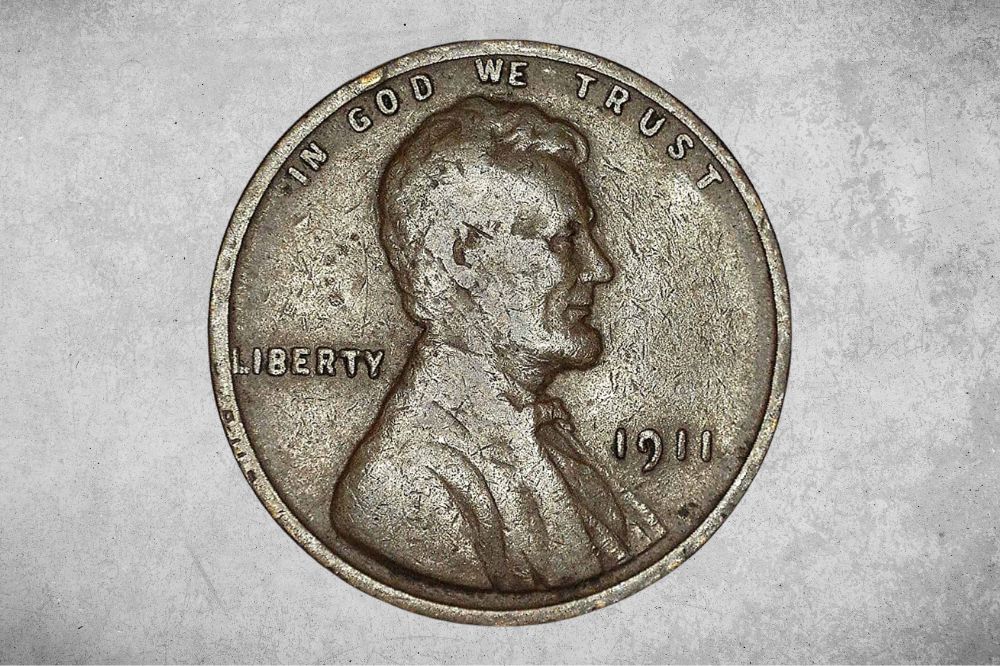Are you thinking of collecting 1911 wheat pennies? Are you wondering if this is a worthy investment? Well, we have some answers for you in this post.
We’ve decided to do a deep dive into the 1911 wheat penny value, its history, and key features. We will even discuss the varieties you will encounter and the errors you need to keep an eye out for.
1911 Wheat Penny Details
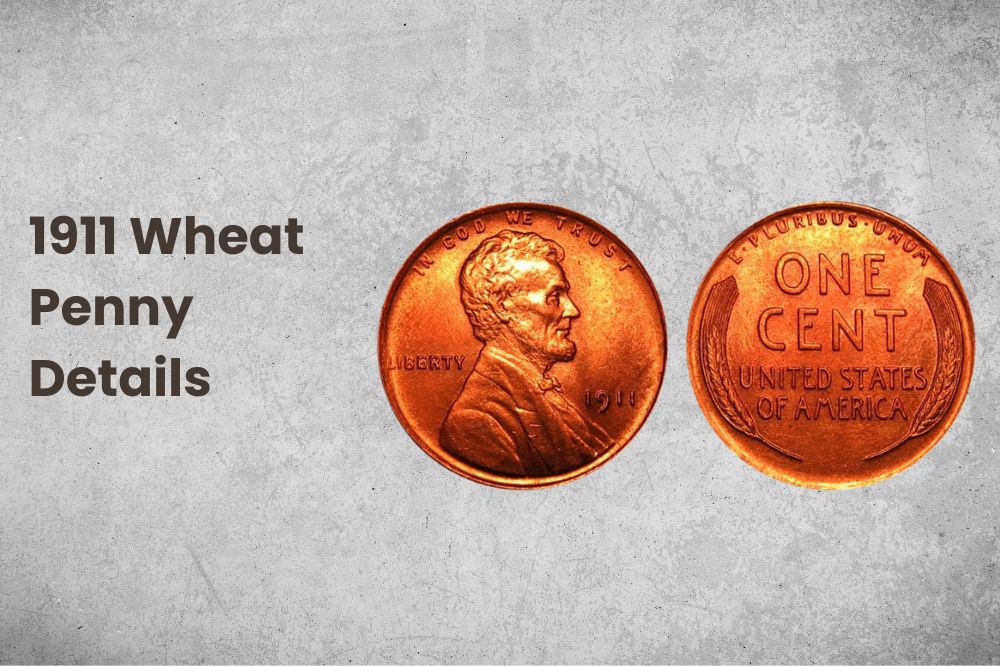
- Category: Lincoln Cents (Wheat Reverse)
- Total Mintage: 117,875,787
- Minting place: Philadelphia, Denver, San Francisco
- Weight: 3.11 g
- Diameter: 19 mm
- Edge: Plain
- Face value: $0.01 (1 cent)
- Composition: 95% copper, 5% zinc & tin
- Engraver: Victor D. Brenner
The 1911 Wheat Penny’s Obverse Design
Like other Lincoln cents, this coin’s obverse features Abraham Lincoln’s right profile. The profile is placed vertically in the middle of the coin and reaches the lower rim of the coin.
There’s just a little space left above Lincoln’s head where the words “IN GOD WE TRUST” are engraved along the coin’s rim. This engraving runs from the left behind Lincoln’s head to the right in front of his forehead.
The word “LIBERTY” is also engraved horizontally on the left side of the coin, behind Lincoln’s neck. On the right lower side of the coin, the year 1911 is engraved.
The 1911 Wheat Penny’s Reverse Design
As its name suggests, the reverse side of this coin features two wheat stalks. These are engraved along the right and left rims of the coin, leaving little uncovered space along the lower rim.
Along the top rim of the coin, the motto “E PLURIBUS UNUM” is written with a dot separating each word. Beneath this legend, in the middle of the coin the words “ONE CENT” and “UNITED STATES OF AMERICA” are written.
The first set of words is noticeably bigger than the second set.
Other Features of the 1911 Wheat Penny
The 1911 wheat penny weighs only 3.11 g and has a plain smooth edge. Also, it has a diameter of 19 mm and is made of a mixture of copper, tin, and zinc. Ultimately, it has the same size, look, and composition as the 1910 penny.
Also Read: Top 20 Most Valuable Old Pennies Worth Money (Penny Collection)
1911 Wheat Penny Value Chart
| 1911 Wheat Penny Value Chart | |||
| Condition | 1911 No Mint Mark Wheat Penny | 1911 “S” Wheat Penny | 1911 “D” Wheat Penny |
| Good (G4) | $0.57 | $35 | $6.80 |
| Very Good (VG8) | $0.81 | $46 | $9.35 |
| Fine (F12) | $1.75 | $57 | $14 |
| Very Fine (VF20) | $2.87 | $75 | $35 |
| Extremely Fine (EF40) | $9.35 | $96 | $75 |
| About Uncirculated (AU50) | $14 | $134 | $96 |
| Uncirculated (MS60) | $23 | $233 | $123 |
| Uncirculated (MS63) | $57 | $409 | $166 |
| Proof (PR63) | $770 | N/A | N/A |
1911 Wheat Penny Value and Varieties Guide
1911 No Mint Mark Wheat Penny Value
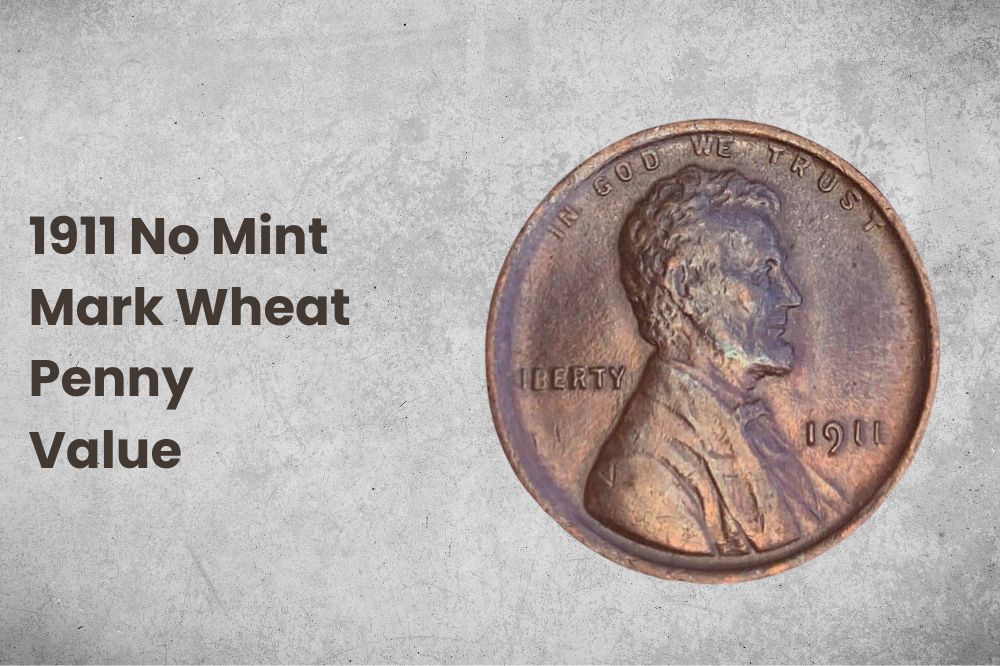
- Type: Lincoln Cents
- Mint Mark: None
- Minting place: Philadelphia
- Year: 1911
- Edge: Plain
- Mintage: 101,177,787
- Designer: Victor D. Brenner
- Face value: $0.01
- Current value: $0.57 to $770
- %Composition: 95% copper and 5% zinc & tin
- Mass: 3.11 g
- Diameter: 19 mm
In 1911, the Philadelphia mint produced 101,177,787 wheat pennies, all of which had no mint mark. Of these, 1,733 were proof coins. These proof coins had a matte finish and are still available today in the colors red, red-brown, and brown.
The first color is the most valuable and the last one is the least valuable. Whatever the case, proof 1911 wheat pennies are more expensive than their regular no-mint counterparts. You can usually buy one of these proof coins for $770 to over $14,000.
On the other hand, the regular Philadelphia 1911 pennies can go for as low as $0.57 per piece. However, this price increases with the condition of your coin and with the redder it gets. As such, a red MS68 one can sell for as high as over $60,000.
1911 “S” Wheat Penny Value
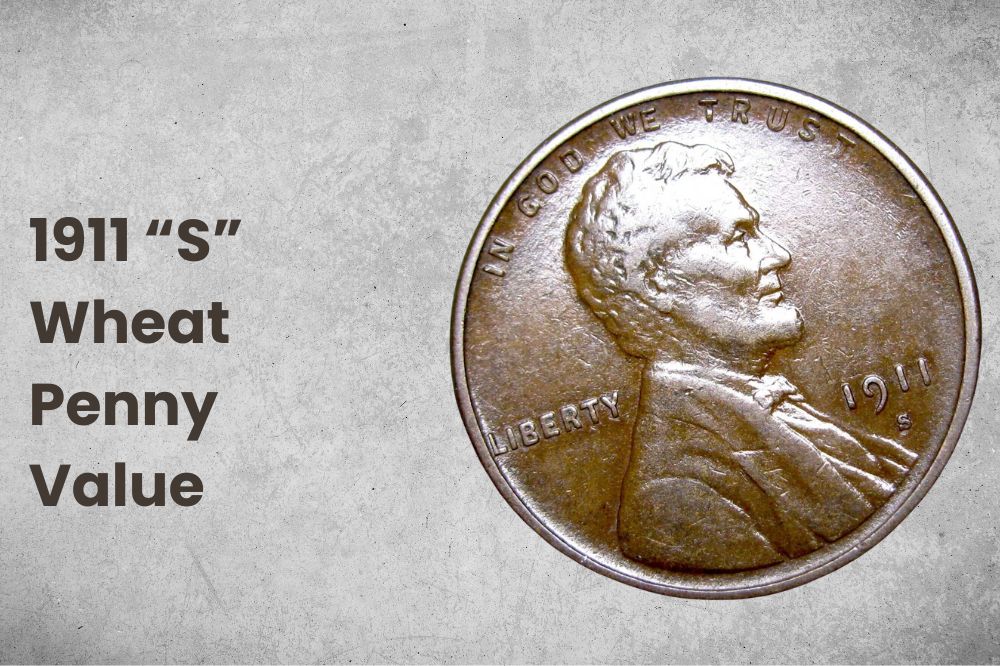
- Type: Lincoln Cents
- Mint Mark: S
- Minting place: San Francisco
- Year: 1911
- Edge: Plain
- Mintage: 4,026,000
- Designer: Victor D. Brenner
- Face value: $0.01
- Current value: $35 to $409
- %Composition: 95% copper and 5% zinc & tin
- Mass: 3.11 g
- Diameter: 19 mm
In 1911, the San Francisco facility minted the lowest number of Lincoln cents; 4,026,000. There were no proofs in this batch and all the coins had an “S” mint mark. This mark was located below the year engraved on the coin.
Because of the lower mintage, these coins are rarer and more expensive than those produced in Denver and the regular strike coins from Philadelphia. An average-grade 1911 S wheat penny will cost you around $35 to $409 today.
Remember, red coins are rarer and more expensive than red-brown and brown ones. It’s therefore not surprising that a red MS66 1911 S penny can go for more than $13,000. Some coins like this have even gone for over $27,000.
1911 “D” Wheat Penny Value
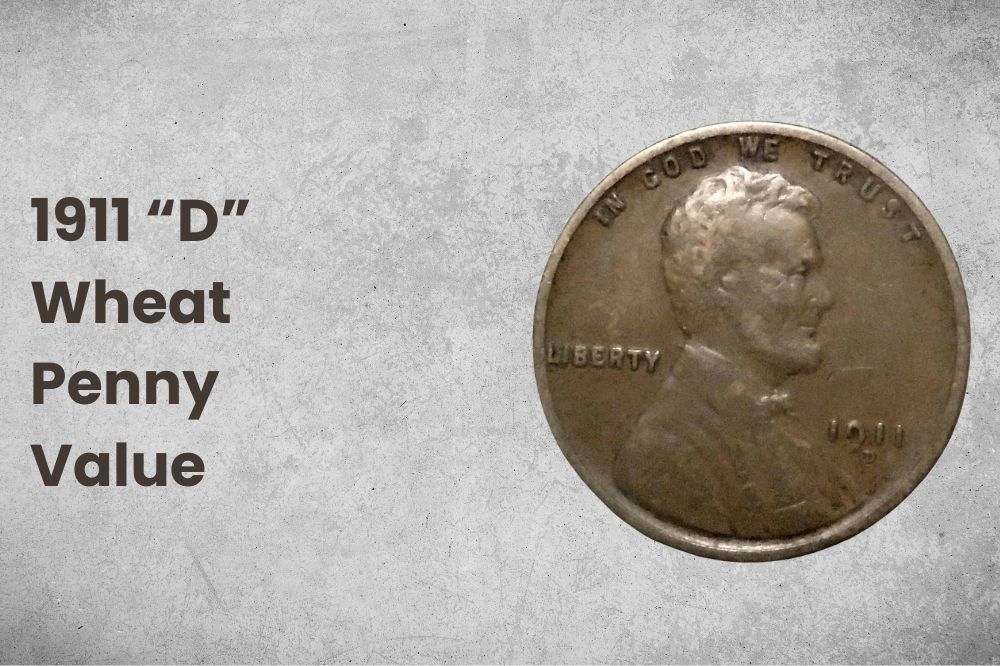
- Type: Lincoln Cents
- Mint Mark: D
- Minting place: Denver
- Year: 1911
- Edge: Plain
- Mintage: 12,672,000
- Designer: Victor D. Brenner
- Face value: $0.01
- Current value: $6 to $166
- %Composition: 95% copper and 5% zinc & tin
- Mass: 3.11 g
- Diameter: 19 mm
The Denver mint produced 12,672,000 wheat pennies in 1911. This was the first time for it to mint pennies and it ensured each one had a D mint mark. This was placed below the year engraving on the coin’s obverse.
These coins are still readily available today for as low as $6.80 to $166 per piece. However, their prices increase with the grade of the coin and its color. As such, a brown MS63 can go for $1,500. A red MS67 1911 D penny can even sell for a whopping $66,000.
1911 Wheat Penny History
Lincoln cents were first minted in 1909 and are still being produced today. They were designed to replace the Indian Head penny and all have the image of Abraham Lincoln on the obverse.
Design Changes
The first obverse and reverse designs of the Lincoln cent were made by Victor D. Brenner. Interestingly, he was not the first to be chosen for this role.
Theodore Roosevelt had originally wanted sculptor Augustus Saint-Gaudens to design the penny and 3 other coins. Unfortunately, Augustus got sick and died before finishing his designs.
That’s when Brenner was brought in. Many speculate that Brenner drew inspiration for his Lincoln profile from an 1864 photo of Lincoln and his son.
One thing’s for sure though; the obverse that Brenner created did not have the “IN GOD WE TRUST” legend that was on the first batch of wheat pennies. The then chief engraver Charles Barber and his boss Frank Leach added this detail.
Another thing to keep in mind is that the first batch of wheat pennies minted in 1909 had Brenner’s initials “VDB” engraved in them. However, within days, the mint removed the initials and new coins were minted without them.
These initials only made a comeback in the 1918 penny. Ultimately, the mint continued to use the 1909 final designs until 1958. In 1959, the wheat reverse design of the coin was changed.
An image of the Lincoln Memorial was placed in the middle of the coin and the legend “ONE CENT” was written along its bottom rim. Along the top rim, the words “UNITED STATES OF AMERICA” were written in a smaller font.
Underneath them, the motto “E PLURIBUS UNUM” was written, just on top of the Lincoln Memorial. There are dots that separate each word. This design was used until 2008; in 2009, four Bicentennial designs replaced it.
These depicted Lincoln’s early years, formative years, professional life, and presidency. But these were used for only one year. In 2010, the reverse design that is still used to date was introduced.
It features a union shield with the motto “ E PLURIBUS UNUM” written on its top section. Across this shield is a scroll bearing the words “ONE CENT”. Under this scroll are the initials of the person who made this design; Lyndall Bass.
Also, the words “UNITED STATES OF AMERICA” are written along the coin’s top rim. Interestingly, the penny’s obverse design was also modified a little bit in 2010.
Composition Changes
Because of increasing tin and copper prices, the composition of the Lincoln cent was changed to 5% zinc and 95% steel. This made them only 2.7 grams and earned them the name wartime cents.
However, they were discontinued within months because they kept staining and corroding. In 1944, the mint introduced coins made of 95% copper and 5% zinc. In 1982, these were replaced with the composition used to date; 97.5% zinc and 2.5% copper.
Changes in Proof Making
All the proof coins made from 1909 to 1917, including the wheat pennies, had a matte finish. This finish was achieved by sandblasting the dies before the coins were struck.
This approach was chosen because the coins of the time had a high relief that would make them lose their details if polishing was done. Keep in mind that the proof coins before this era had a shiny surface that was the result of scrubbing dies using horse hair brushes.
This method of creating proofs was only used again from 1936; no proofs were made from 1918 to 1936. However, scrubbing eventually became obsolete. In 1970, mints started using computerized lasers; they still use them today.
1911 Wheat Penny Grading
You can either grade your 1911 wheat penny yourself or send it to a professional to do it for you. If you choose the latter, you’ll need to learn how to examine the condition of a coin. You will not only have to look at its engravings but also its luster.
List of 1911 Wheat Penny Errors
1911 Wheat Penny Repunched Mint Mark (RPM)
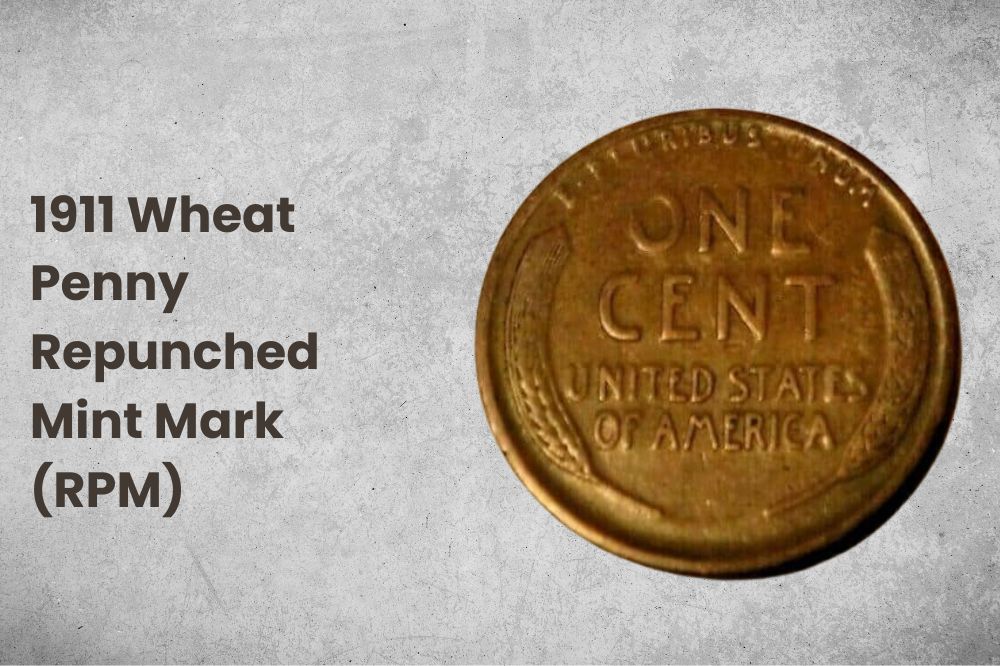
An RPM error happens when the punch used to impress a mint mark leaves more than one impression on the coin. In 1911 wheat pennies, this error was only possible in those produced in San Francisco or Denver.
When it happens in the former and leaves two impressions, it’s referred to as an S over S (S/S) RPM. If the same thing happens with the latter type of coin, it’s referred to as a D over D (D/D) RPM. Either way, this error increases the value of a coin.
In 2019, a red-brown PCGS MS65 1911 S/S penny sold for $1,320. In 2022, another one graded at MS65 and brown in color sold at $1,750. On the other hand, a brown MS64 1911 D/D wheat penny sold for $910 in 2022.
Keep in mind D/D RPMs are more difficult to identify in 1911 wheat pennies than S/S ones. This is because Denver mint marks in these pennies are not sharply struck. This also makes them cheaper than their S/S counterparts.
Another thing you should know is that in some rare cases, you can find a 1911 wheat penny with three D impressions. This is no longer called a D/D RPM but rather a D over D over D (D/D/D) RPM error.
1911 Wheat Penny FAQ
What makes a 1911 wheat penny valuable?
A 1911 wheat penny gets more valuable the better condition it’s in, the redder it is, and the more unique errors it has. The more distinct these errors are, the more valuable the coin becomes.
Is a 1911 penny rare?
While the no-mint 1911 wheat penny isn’t rare, the S type is. This is because of its low mintage. After all, it has the 6th lowest mintage of all wheat penny series. This makes it rare in all grades.
What is the rarest wheat penny?
The rarest wheat penny is the 1909 S penny with the initials VDB on it. It has the lowest recorded mintage in the wheat penny series; 484,000. Another rare wheat penny is the 1932 S; only 886,000 pieces of this type were struck.
